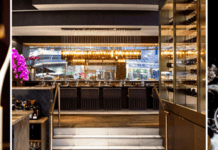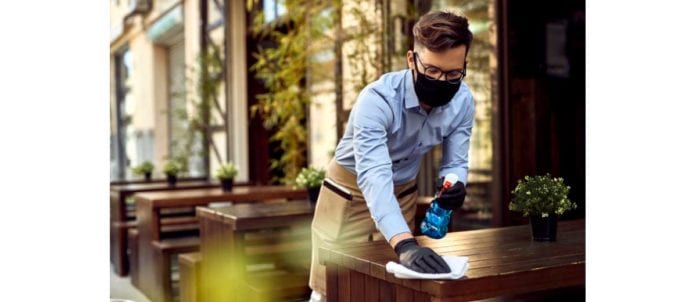In a COVID-19 world, operators are elevating their sanitation practices like never before
As restaurant re-openings move forward, proper sanitation and “cleaning practices will be critical benchmarks to success. Whether it’s a fine-dining or takeout establishment, consumers are increasingly vigilant about the health-and-safety practices of the restaurants they frequent.
“The important thing to consider is that customers are watching,” says Chris Boyles, VP of Food Safety for Steritech, in Charlotte, N.C. “Cleaning and disinfecting used to be kept behind the scenes. Now restaurants are purposely showing practices to instill customer and team-member confidence.”
Cleaning practices have always been an important aspect of the hospitality industry. But now the stakes are exponentially higher, says Jenny Companion, VP Eastern Operations for The Fifteen Group in Toronto. “What they’re using to clean may not have changed, but how often and how thoroughly they use it has.”
The good news is there’s a growing interest in equipment innovation and best practices to draw from that can help the cause. But, even so, many operators and their staff are facing a significant learning curve.
“Everyone understanding cleanliness from a virology standpoint needs to be at the forefront of operations,” says Josh Wolfe, director of Sales at Food Service Solutions Inc. in Toronto. “The big challenge is people don’t know how to do it effectively. There’s a lot of misinformation around processes and procedures and little guidance in the way of protocols.”
Wolfe has been involved in dozens of walkthroughs to assess sanitation practices, and says even the best-intended practices could use some work. One main challenge is identifying all hotspots in an establishment. “There are high touchpoints that people don’t see and are not necessarily identified on the sanitation list, such as under chairs or fridge-door frames. You need to talk about sanitizing areas, not just handles and [visible] surfaces.”
Another common mistake is wiping down surfaces too quickly. The reality is, chemicals in sanitizers require a dwell time to be effective, which can range anywhere from three to 10 minutes. “This presents a real problem, since most people don’t know about dwell time and purveyors are not conveying the message,” says Wolfe.
“Dwell time is the piece that is most misunderstood or not even considered,” adds Boyles. “All chemicals have a time they have to stay wet to be effective, which will be indicated on the label. It doesn’t mean it’s useless to just wipe and dine, but you won’t get the full effect.”
Choosing the right equipment for sanitizing establishments is critical. Spray systems in particular fall under four categories, explains Wolfe. The first is the handheld pump spray. “These can be labour intensive and dispense large, inconsistent droplets, so they don’t necessarily deliver large volumes of chemicals at once. If you go too fast, (which is typical), you are not sanitizing effectively.”
The second is electrostatic sprayers that were originally designed for the paint industry. “When sprayed at a surface, they stick very effectively and have a wrap effect around the sides and backs of objects,” says Wolfe. “However, because they were designed for paint, they tend to be over-pressurized, have a high rate of failure and the droplets are inconsistent.”
The third is fogging, which replaces all the air with a mist. This requires special equipment and a person wearing a respirator. “It’s not an effective option as a day-to-day or minute-to-minute solution,” he notes.
A new technology making its way into the foodservice industry is purpose-built airless, non-pressurized sanitizers that offer a wider spray pattern, consistent droplet sizes and specialized internal parts that can’t be corroded by chemicals. “Users can deliver a perfect thin film of spray that doesn’t need to be wiped and covers vast areas quickly, including nooks and crannies. Systems start at around $1,400,” says Wolfe.
Boyles cautions people need to check labels for special protective-equipment requirements (some require goggles) and reminders of chemical mixing dangers.
Now that airborne transmission of COVID-19 is confirmed, restaurant areas and, in particular, ventilation systems, will likely need upgrades or, at the very least, more-stringent monitoring. One effective way to reduce airborne transmissions is to increase outside air coming into the facility. Another is advanced filtration systems.
IoT platform developer Senseware based in Vienna, Va. has introduced new plug-and-play particle-counter sensors that can track air quality — including pathogens — in real time and alert operators when particles exceed pre-set limits.
Beyond equipment, there are other practices that can help restaurants reduce the risk of contamination. One is staff assignments, Companion notes. “Where possible, there should be staff members specifically assigned to sanitization. For example, taking dirty dishes from tables, cleaning surfaces and utensils and sanitizing tables between turnovers.”
A key area to consider is the dishwashing station, she adds. “You need to set up/prepare the station with enhanced PPE (impermeable aprons, face masks/shields, heavy gloves) and create a clear separation between clean and dirty — one person only touches dirty products and rinses, while the other only touches the clean dishes.”
It also helps to advise guest limits on tables so there is enough time to clean and sanitize tables between sittings.
Plexiglass shields are especially helpful for more-confined restaurant spaces where physical distancing is a challenge.
Jim Romer owns three Romer’s Burgers locations in Vancouver and Port Moody, B.C.. With occupancy reduced by half, he wanted to create an environment that was safe for guests and staff. The only caveat was that demand was so high, barriers were in short supply.
He found a designer who built a series of movable plexiglass walls that can be easily reconfigured. The total cost for all three restaurants was $10,000. “It changed the feel of the dining room a bit. But we know people need to be extra safe when they’re going out [to eat].”
By Denise Deveau

















